تيكتاليك
| التيكتاليك Tiktaalik | |
|---|---|
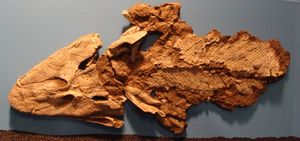
| |
| التيكتاليك في متحف فيلد، شيكاگو. | |
| التصنيف العلمي | |
| أصنوفة غير معروفة (أصلحها): | Elpistostegalia |
| فرع: | مسقوفات الرأس |
| جنس: | †تيكتاليك دشلر, شوبن و جنكنز 2006 |
| Type species | |
| †Tiktaalik roseae Daeschler, Shubin & Jenkins, 2006
| |
التيكتاليك Tiktaalik /tɪkˈtɑːlɪk/، هو أحادي النوع من لحميات الزعانف المنقرضة من أواخر العصر الديڤوني، وتتميز بالعديد من الخصائص المشابهة لذوات الأربع.[1] وهي مثال من الخطوط المختلفة للتكيفات المتطورة للحميات الزعانف للانتقال إلى الموائل الضحلة التي تفتقر للأكسجين، مما إدى إلى تطور رباعية الأطراف.[2] عُثر على أحفورات محفوظة بشكل جيد في 2005 على جزيرة إلـِسمير، في نوناڤوت، كندا.
الوصف
تمنح تيكتاليك فرصة لنظرات سابرة في سمات أقرب الأقارب المنقرضين لذوات الأربع. Unlike many previous, more fishlike transitional fossils, the "fins" of Tiktaalik have basic wrist bones and simple rays reminiscent of fingers. The homology of distal elements is uncertain; there have been suggestions that they are homologous to digits, although this is incompatible with the digital arch developmental model because digits are supposed to be postaxial structures, and only three of the (reconstructed) eight rays of Tiktaalik are post-axial.[3] However, the proximal series can be directly compared to the ulnare and intermedium of tetrapods. The fin was clearly weight bearing, being attached to a massive shoulder with expanded scapular and coracoid elements and attached to the body armor, large muscular scars on the ventral surface of the humerus, and highly mobile distal joints. The bones of the fore fins show large muscle facets, suggesting that the fin was both muscular and had the ability to flex like a wrist joint. These wrist-like features would have helped anchor the creature to the bottom in fast moving current.[4][5]
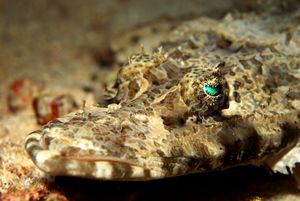
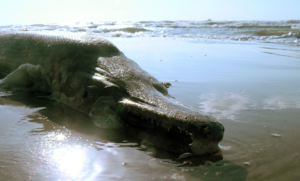
Also notable are the spiracles on the top of the head, which suggest the creature had primitive lungs as well as gills. This would have been useful in shallow water, where higher water temperature would lower oxygen content. This development ربما قد أدى إلى تطور فقص صدري أكثر قوة، a key evolutionary trait of land living creatures.[2] The more robust ribcage of Tiktaalik would have helped support the animal’s body any time it ventured outside a fully aquatic habitat. Tiktaalik also lacked a characteristic that most fishes have—bony plates in the gill area that restrict lateral head movement. This makes Tiktaalik the earliest known fish to have a neck, with the pectoral girdle separate from the skull. This would give the creature more freedom in hunting prey either on land or in the shallows.[5]
Tiktaalik is sometimes compared to gars (esp. Atractosteus spatula, the alligator gar) of the Lepisosteidae family, with whom it shares a number of characteristics:[6]
- diamond-shaped scale patterns common to the Crossopterygii class (in both species scales are rhombic, overlapping and tuberculated);
- teeth structured in two rows;
- both internal and external nostrils;
- tubular and streamlined body;
- absence of anterior dorsal fin;
- broad, dorsoventrally compressed skull;
- dorsally placed eyes;
- paired frontal bones;
- marginal nares;
- subterminal mouth;
- lung-like organ.
علم الأحياء العتيقة
Tiktaalik generally had the characteristics of a lobe-finned fish, but with front fins featuring arm-like skeletal structures more akin to a crocodile, including a shoulder, elbow, and wrist. The fossil discovered in 2004 did not include the rear fins and tail. It had rows[7] of sharp teeth of a predator fish, and its neck could move independently of its body, which is not common in other fish (Tarrasius, Mandageria, placoderms,[8][9] and extant seahorses being some exceptions; see also Lepidogalaxias and Channallabes apus[10]). The animal had a flat skull resembling a crocodile's; eyes on top of its head, suggesting that it spent a lot of time looking up; a neck and ribs similar to those of tetrapods, with the ribs being used to support its body and aid in breathing via lungs; well developed jaws suitable for catching prey; and a small gill slit called a spiracle that, in more derived animals, became an ear.[11]
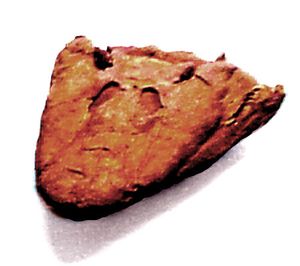
The fossils were found in the "Fram Formation", deposits of meandering stream systems near the Devonian equator, suggesting a benthic animal that lived on the bottom of shallow waters and perhaps even out of the water for short periods, with a skeleton indicating that it could support its body under the force of gravity whether in very shallow water or on land.[12] At that period, for the first time, deciduous plants were flourishing and annually shedding leaves into the water, attracting small prey into warm oxygen-poor shallows that were difficult for larger fish to swim in.[2] The discoverers said that in all likelihood, Tiktaalik flexed its proto-limbs primarily on the floor of streams and may have pulled itself onto the shore for brief periods.[13] Neil Shubin and Ted Daeschler, the leaders of the team, have been searching Ellesmere Island for fossils since 2000[4][14]
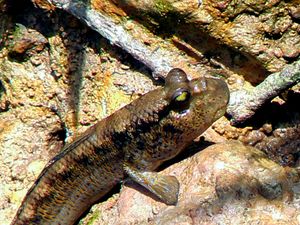
We're making the hypothesis that this animal was specialized for living in shallow stream systems, perhaps swampy habitats, perhaps even to some of the ponds. And maybe occasionally, using its very specialized fins, for moving up overland. And that's what is particularly important here. The animal is developing features which will eventually allow animals to exploit land.
— Ted Daeschler، [15]
التصنيف والتطور

- Panderichthys, suited to muddy shallows;
- Tiktaalik with limb-like fins that could take it onto land;
- Early tetrapods in weed-filled swamps, such as:
- Acanthostega which had feet with eight digits,
- Ichthyostega with limbs.
Tiktaalik roseae is the only species classified under the genus. Tiktaalik lived approximately 375 million years ago. Paleontologists suggest that it is representative of the transition between non-tetrapod vertebrates (fish) such as Panderichthys, known from fossils 380 million years old, and early tetrapods such as Acanthostega and Ichthyostega, known from fossils about 365 million years old. Its mixture of primitive fish and derived tetrapod characteristics led one of its discoverers, Neil Shubin, to characterize Tiktaalik as a "fishapod".[4][16]
Tiktaalik is a transitional fossil; it is to tetrapods what Aurornis is to birds, troodonts and dromaeosaurids. While it may be that neither is ancestor to any living animal, they serve as evidence that intermediates between very different types of vertebrates did once exist. The mixture of both fish and tetrapod characteristics found in Tiktaalik include these traits:
- الأسماك
- fish gills
- fish scales
- fish fins
- "Fishapod"
- half-fish, half-tetrapod limb bones and joints, including a functional wrist joint and radiating, fish-like fins instead of toes
- half-fish, half-tetrapod ear region
- Tetrapod
- tetrapod rib bones
- tetrapod mobile neck with separate pectoral girdle
- tetrapod lungs
Putative tetrapod footprints found in Poland and reported in Nature in January 2010 were "securely dated" at 10 million years older than the oldest known elpistostegids.[17] If this is a true tetrapod record, Tiktaalik was a "late-surviving relic" rather than the original transitional form. An alternative interpretation is that the Polish trackways, which do not have digital impressions, were made by walking fish [18]
الاكتشاف
In 2004, three fossilized Tiktaalik skeletons were discovered in rock formed from late Devonian river sediments on Ellesmere Island, Nunavut, in northern Canada.[19][20] At the time of the species' existence, Ellesmere Island was part of the continent Laurentia (modern eastern North America and Greenland),[21] which was centered on the equator and had a warm climate.
The remarkable find was made by a paleontologist who noticed the skull sticking out of a cliff. On further inspection, the ancient animal was found to be in excellent condition for a 383-million-year-old specimen.[4][14]
The discovery, made by Edward B. Daeschler of the Academy of Natural Sciences, Neil H. Shubin from the University of Chicago, and Harvard University Professor Farish A. Jenkins, Jr, was published in the April 6, 2006 issue of Nature[1] and quickly recognized as a classic example of a transitional form. Jennifer A. Clack, a Cambridge University expert on tetrapod evolution, said of Tiktaalik, "It's one of those things you can point to and say, 'I told you this would exist,' and there it is."[5]

After five years of digging on Ellesmere Island, in the far north of Nunavut, they hit pay dirt: a collection of several fish so beautifully preserved that their skeletons were still intact. As Shubin's team studied the species they saw to their excitement that it was exactly the missing intermediate they were looking for. 'We found something that really split the difference right down the middle,' says Daeschler.
The name Tiktaalik is an Inuktitut word meaning "burbot", a freshwater fish related to true cod.[23] The "fishapod" genus received this name after a suggestion by Inuit elders of Canada's Nunavut Territory, where the fossil was discovered.[21] The specific name roseae cryptically honours an anonymous donor.[24]
Taking a detailed look at the internal head skeleton of Tiktaalik roseae, in the October 16, 2008, issue of Nature,[25] researchers show how Tiktaalik was gaining structures that could allow it to support itself on solid ground and breathe air, a key intermediate step in the transformation of the skull that accompanied the shift to life on land by our distant ancestors.[26]
مرئيات
- حلقة بين السمك والحيوانات الراجلة
انظر أيضاً
أحفورات لحميات زعانف أخرى من العصر الديڤوني:
المصادر
- ^ أ ب Edward B. Daeschler, Neil H. Shubin and Farish A. Jenkins, Jr (6 April 2006). "A Devonian tetrapod-like fish and the evolution of the tetrapod body plan". Nature. 440 (7085): 757–763. doi:10.1038/nature04639. PMID 16598249.
{{cite journal}}: CS1 maint: multiple names: authors list (link) - ^ أ ب ت Jennifer A. Clack, Scientific American, Getting a Leg Up on Land Nov. 21, 2005.
- ^ Laurin M (2006). "Scanty evidence and changing opinions about evolving appendages". Zoologica Scripta. 35 (6): 667–668. doi:10.1111/zsc.2006.35.issue-6.
- ^ أ ب ت ث Shubin, Neil (2008). Your Inner Fish. Pantheon. ISBN 978-0-375-42447-2.
- ^ أ ب ت "Meet Your ancestor, the Fish that crawled". New Scientist Magazine. Retrieved 2007-02-07.
- ^ Spitzer, Mark (2010). Season of the Gar: Adventures in Pursuit of America's Most Misunderstood Fish. University of Arkansas Press. pp. 65–66. ISBN 978-1-55728-929-2.
- ^ "Fossil Suggests Missing Link From Fish to Land". NPR (National Public Radio). Retrieved 2006-11-27.
- ^ "Fossil Musculature of the Most Primitive Jawed Vertebrates". Science. 341 (6142): 160–164. 12 July 2013. doi:10.1126/science.1237275.
{{cite journal}}: Cite uses deprecated parameter|authors=(help) - ^ "Primitive fish could nod but not shake its head: Ancient fossils reveal surprises about early vertebrate necks, abdominal muscles". Science News. June 13, 2013.
- ^ Sam Van Wassenbergh, Anthony Herrel, Dominique Adriaens, Frank Huysentruyt, Stijn Devaere, and Peter Aerts (13 April 2006). "Evolution: A catfish that can strike its prey on land". Nature. 440 (7086): 881. doi:10.1038/440881a. PMID 16612372.
{{cite journal}}: CS1 maint: multiple names: authors list (link) - ^ "The fish that crawled out of the water". Nature. Retrieved 2006-04-06.
- ^ The Academy of Natural Sciences, Philadelphia, press release April 3, 2006. (doc)
- ^ Neil H. Shubin, Edward B. Daeschler and Farish A. Jenkins, Jr (6 April 2006). "The pectoral fin of Tiktaalik roseae and the origin of the tetrapod limb". Nature. 440 (7085): 764–771. doi:10.1038/nature04637. PMID 16598250.
{{cite journal}}: CS1 maint: multiple names: authors list (link) - ^ أ ب Peterson, Britt (April 5, 2006). "An Evolutionary Finding". Seed. Retrieved 2006-04-05.
- ^ NewsHour, Fossil Discovery, April 6, 2006.
- ^ John Noble Wilford, The New York Times, Scientists Call Fish Fossil the Missing Link, Apr. 5, 2006.
- ^ Niedzwiedzki G., Szrek P., Narkiewicz K., Narkiewicz M, Ahlberg P. (2010). "Tetrapod trackways from the early Middle Devonian period of Poland" (PDF). Nature. 463 (7227): 43–48.
{{cite journal}}: CS1 maint: multiple names: authors list (link) - ^ King, H.; et al. "Behavioral evidence for the evolution of walking and bounding before terrestriality in sarcopterygian fishes". PNAS.
{{cite journal}}: Explicit use of et al. in:|author=(help) - ^ Gorner, Peter (2006-04-05). "Fossil could be fish-to-land link". Chicago Tribune.
- ^ Easton, John (2008-10-23). "Tiktaalik's internal anatomy explains evolutionary shift from water to land". University of Chicago Chronicle. University of Chicago. 28 (3). Retrieved 2009-07-19.
- ^ أ ب Spotts, Peter (April 6, 2006). "Fossil fills gap in move from sea to land". The Christian Science Monitor. Retrieved 2006-04-05.
- ^ Holmes, Bob (5 April 2006). "First fossil of fish that crawled onto land discovered". New Scientist News. Retrieved 2006-04-07.
- ^ Nunavut Living Dictionary. Entry for tiktaalik
- ^ Coyne, Jerry (2009). Why Evolution is True. Viking. ISBN 978-0-670-02053-9.
- ^ Jason P. Downs, Edward B. Daeschler, Farish A. Jenkins & Neil H. Shubin (16 October 2008). "The cranial endoskeleton of Tiktaalik roseae". Nature. 455 (7215): 925–929. doi:10.1038/nature07189. PMID 18923515.
{{cite journal}}: CS1 maint: multiple names: authors list (link) - ^ "Fishapod" Reveals Origins of Head and Neck Structures of First Land Animals Newswise, Retrieved on October 15, 2008.
وصلات خارجية
- University of Chicago website dedicated to the discovery
- Interview with Neil Shubin on The Inoculated Mind, February 12, 2008.
- Interview with Neil Shubin on Tech Nation where he discusses the discovery of the Tiktaalik, February 14, 2008.
- Lecture (presentation) by Neil Shubin about the discovery of Tiktaalik at YouTube
- Fishapod stars in music video, YouTube. Accessed on December 27, 2008.
- CS1 errors: deprecated parameters
- Automatic taxobox cleanup
- Automatic taxoboxes relying on page title
- Pages with empty portal template
- مقالات جيدة
- أحفورات وصفت في 2006
- Lobe-finned fish
- أسماك عظمية ما قبل التاريخ
- أسماك العصر الديڤوني
- أسماك قبل التاريخ في أمريكا الشمالية
- أحفورات انتقالية
- أجناس أسماك أحادية النوع



